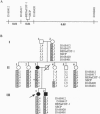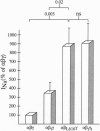Abstract
Liddle syndrome is a mendelian form of hypertension characterized by constitutively elevated renal Na reabsorption that can result from activating mutations in the beta or gamma subunit of the epithelial Na channel. All reported mutations have deleted the last 45-76 normal amino acids from the cytoplasmic C terminus of one of these channel subunits. While these findings implicate these terminal segments in the normal negative regulation of channel activity, they do not identify the amino acid residues that are critical targets for these mutations. Potential targets include the short highly conserved Pro-rich segments present in the C terminus of beta and gamma subunits; these segments are similar to SH3-binding domains that mediate protein-protein interaction. We now report a kindred with Liddle syndrome in which affected patients have a mutation in codon 616 of the beta subunit resulting in substitution of a Leu for one of these highly conserved Pro residues. The functional significance of this mutation is demonstrated both by the finding that this is a de novo mutation appearing concordantly with the appearance of Liddle syndrome in the kindred and also by the marked activation of amiloride-sensitive Na channel activity seen in Xenopus oocytes expressing channels containing this mutant subunit (8.8-fold increase compared with control oocytes expressing normal channel subunits; P = 0.003). These findings demonstrate a de novo missense mutation causing Liddle syndrome and identify a critical channel residue important for the normal regulation of Na reabsorption in humans.
Full text
PDF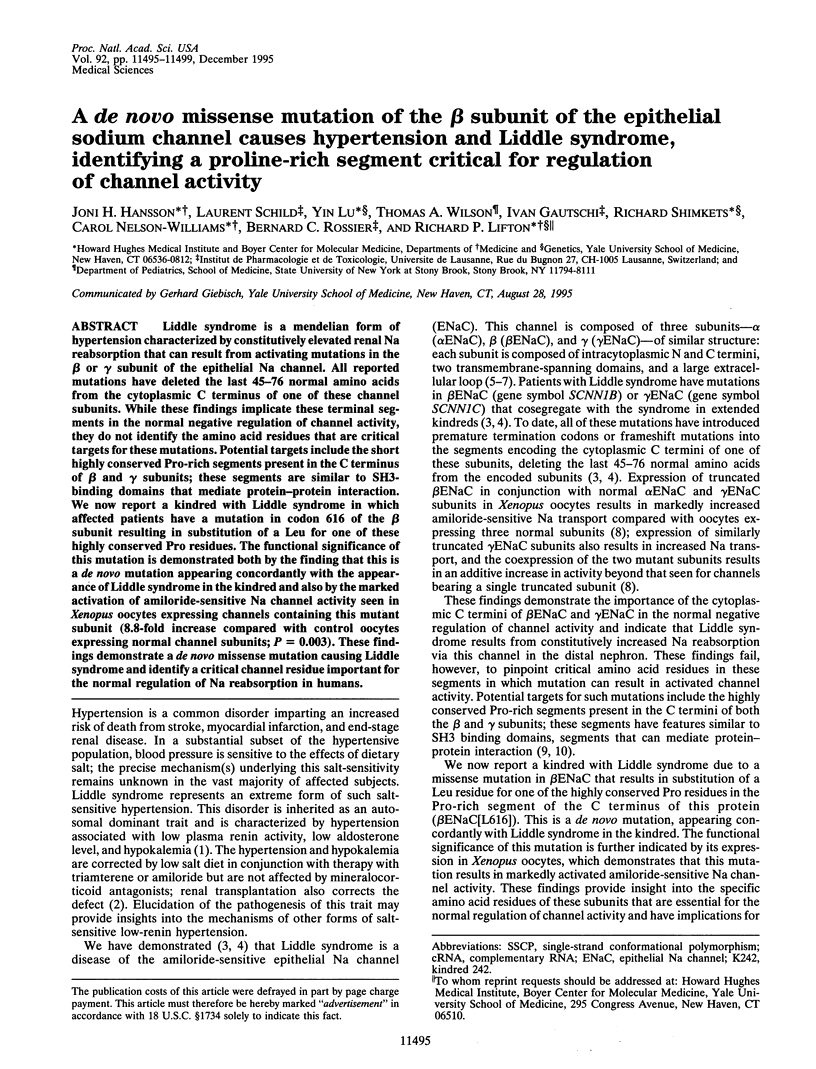
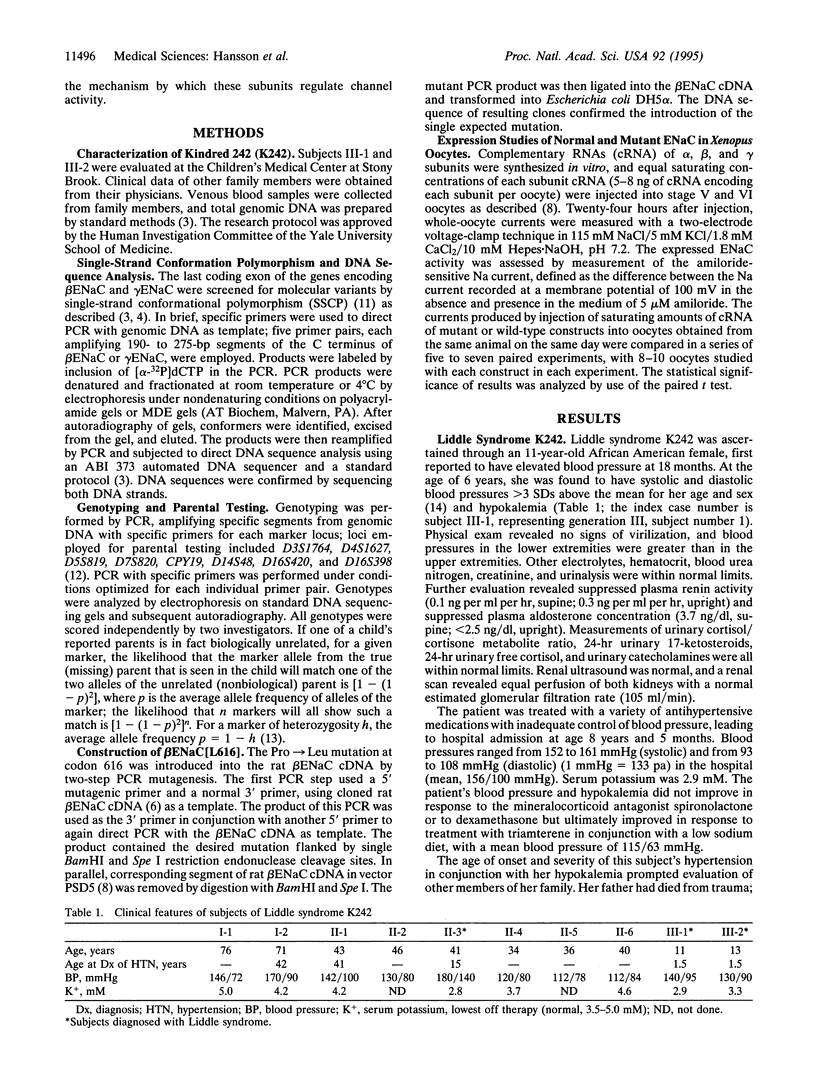
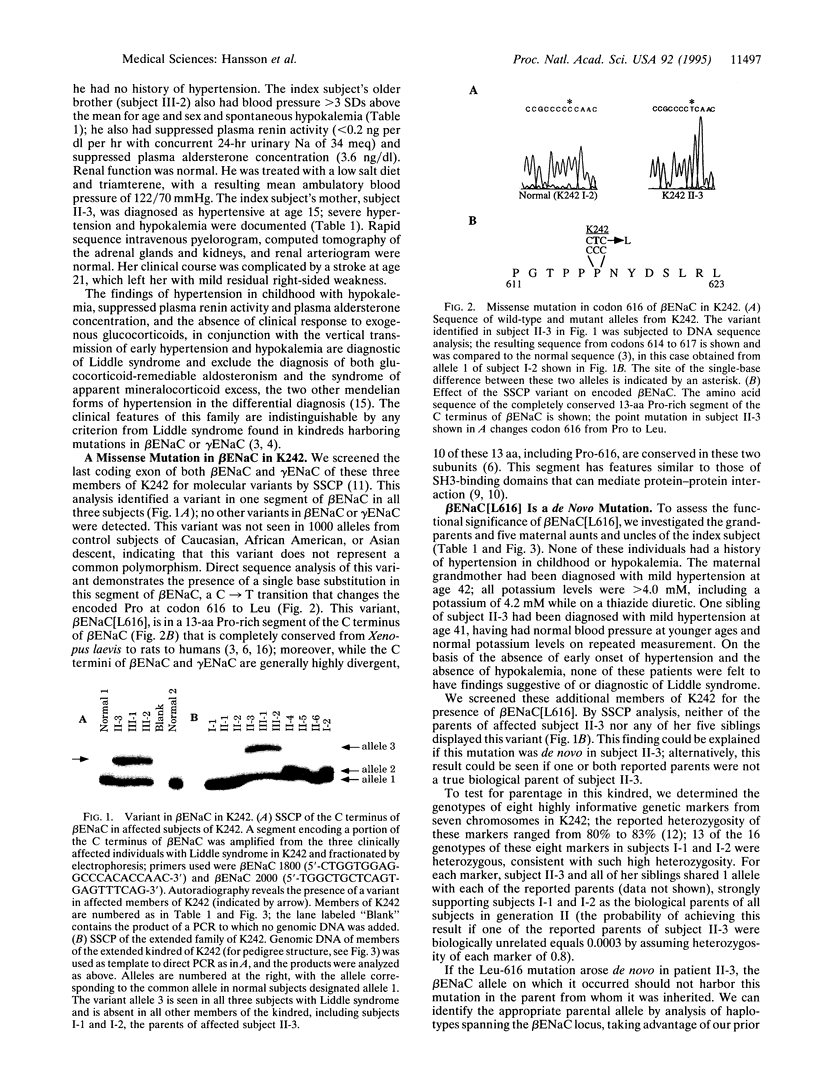
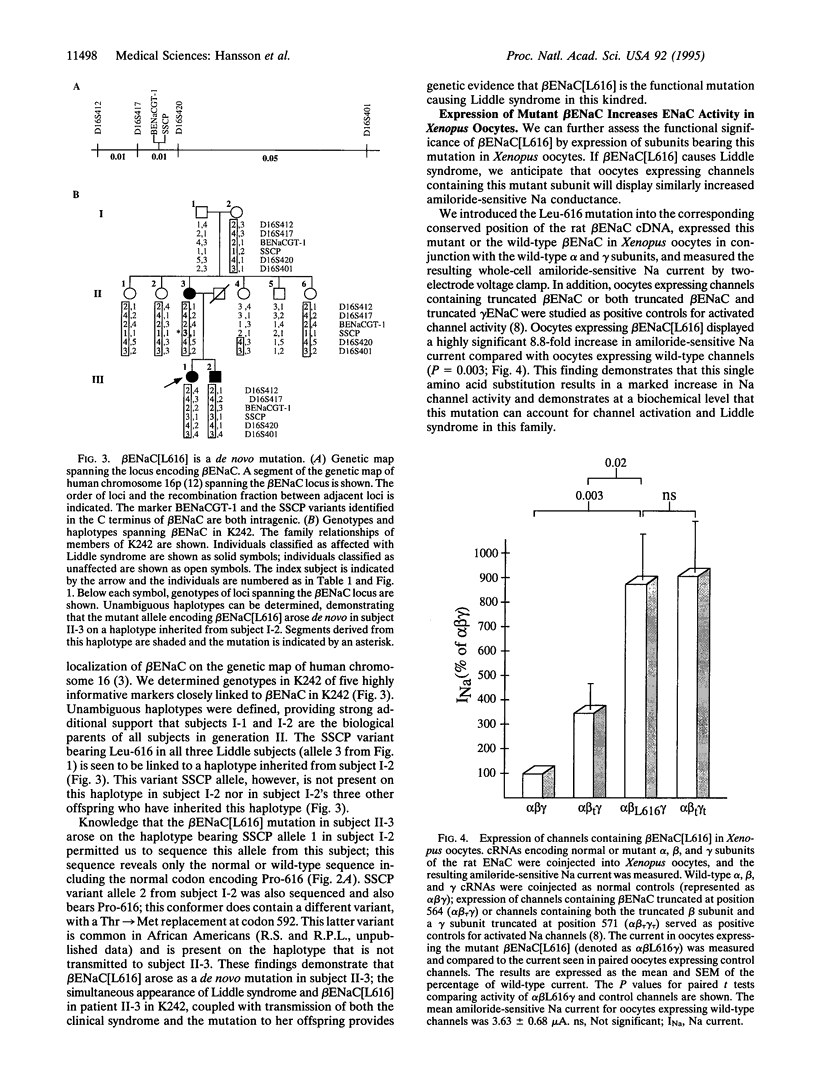
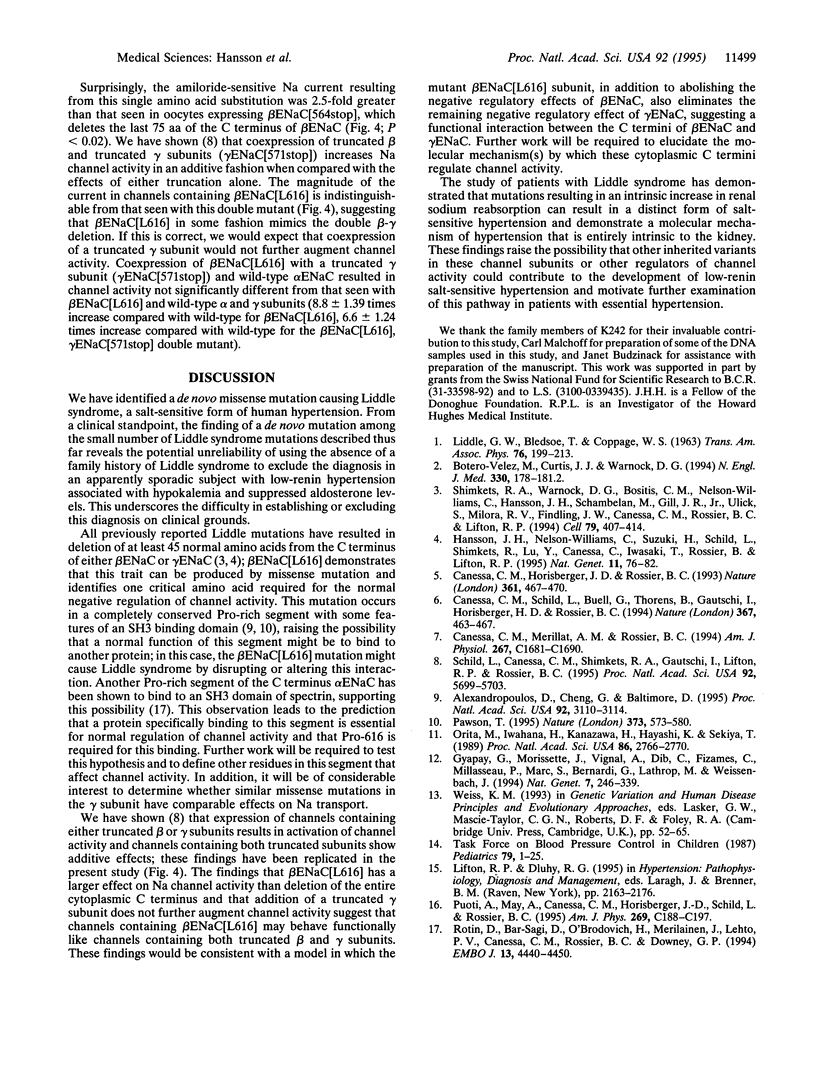
Images in this article
Selected References
These references are in PubMed. This may not be the complete list of references from this article.
- Alexandropoulos K., Cheng G., Baltimore D. Proline-rich sequences that bind to Src homology 3 domains with individual specificities. Proc Natl Acad Sci U S A. 1995 Apr 11;92(8):3110–3114. doi: 10.1073/pnas.92.8.3110. [DOI] [PMC free article] [PubMed] [Google Scholar]
- Botero-Velez M., Curtis J. J., Warnock D. G. Brief report: Liddle's syndrome revisited--a disorder of sodium reabsorption in the distal tubule. N Engl J Med. 1994 Jan 20;330(3):178–181. doi: 10.1056/NEJM199401203300305. [DOI] [PubMed] [Google Scholar]
- Canessa C. M., Horisberger J. D., Rossier B. C. Epithelial sodium channel related to proteins involved in neurodegeneration. Nature. 1993 Feb 4;361(6411):467–470. doi: 10.1038/361467a0. [DOI] [PubMed] [Google Scholar]
- Canessa C. M., Merillat A. M., Rossier B. C. Membrane topology of the epithelial sodium channel in intact cells. Am J Physiol. 1994 Dec;267(6 Pt 1):C1682–C1690. doi: 10.1152/ajpcell.1994.267.6.C1682. [DOI] [PubMed] [Google Scholar]
- Canessa C. M., Schild L., Buell G., Thorens B., Gautschi I., Horisberger J. D., Rossier B. C. Amiloride-sensitive epithelial Na+ channel is made of three homologous subunits. Nature. 1994 Feb 3;367(6462):463–467. doi: 10.1038/367463a0. [DOI] [PubMed] [Google Scholar]
- Gyapay G., Morissette J., Vignal A., Dib C., Fizames C., Millasseau P., Marc S., Bernardi G., Lathrop M., Weissenbach J. The 1993-94 Généthon human genetic linkage map. Nat Genet. 1994 Jun;7(2 Spec No):246–339. doi: 10.1038/ng0694supp-246. [DOI] [PubMed] [Google Scholar]
- Hansson J. H., Nelson-Williams C., Suzuki H., Schild L., Shimkets R., Lu Y., Canessa C., Iwasaki T., Rossier B., Lifton R. P. Hypertension caused by a truncated epithelial sodium channel gamma subunit: genetic heterogeneity of Liddle syndrome. Nat Genet. 1995 Sep;11(1):76–82. doi: 10.1038/ng0995-76. [DOI] [PubMed] [Google Scholar]
- Orita M., Iwahana H., Kanazawa H., Hayashi K., Sekiya T. Detection of polymorphisms of human DNA by gel electrophoresis as single-strand conformation polymorphisms. Proc Natl Acad Sci U S A. 1989 Apr;86(8):2766–2770. doi: 10.1073/pnas.86.8.2766. [DOI] [PMC free article] [PubMed] [Google Scholar]
- Pawson T. Protein modules and signalling networks. Nature. 1995 Feb 16;373(6515):573–580. doi: 10.1038/373573a0. [DOI] [PubMed] [Google Scholar]
- Puoti A., May A., Canessa C. M., Horisberger J. D., Schild L., Rossier B. C. The highly selective low-conductance epithelial Na channel of Xenopus laevis A6 kidney cells. Am J Physiol. 1995 Jul;269(1 Pt 1):C188–C197. doi: 10.1152/ajpcell.1995.269.1.C188. [DOI] [PubMed] [Google Scholar]
- Rotin D., Bar-Sagi D., O'Brodovich H., Merilainen J., Lehto V. P., Canessa C. M., Rossier B. C., Downey G. P. An SH3 binding region in the epithelial Na+ channel (alpha rENaC) mediates its localization at the apical membrane. EMBO J. 1994 Oct 3;13(19):4440–4450. doi: 10.1002/j.1460-2075.1994.tb06766.x. [DOI] [PMC free article] [PubMed] [Google Scholar]
- Schild L., Canessa C. M., Shimkets R. A., Gautschi I., Lifton R. P., Rossier B. C. A mutation in the epithelial sodium channel causing Liddle disease increases channel activity in the Xenopus laevis oocyte expression system. Proc Natl Acad Sci U S A. 1995 Jun 6;92(12):5699–5703. doi: 10.1073/pnas.92.12.5699. [DOI] [PMC free article] [PubMed] [Google Scholar]
- Shimkets R. A., Warnock D. G., Bositis C. M., Nelson-Williams C., Hansson J. H., Schambelan M., Gill J. R., Jr, Ulick S., Milora R. V., Findling J. W. Liddle's syndrome: heritable human hypertension caused by mutations in the beta subunit of the epithelial sodium channel. Cell. 1994 Nov 4;79(3):407–414. doi: 10.1016/0092-8674(94)90250-x. [DOI] [PubMed] [Google Scholar]




